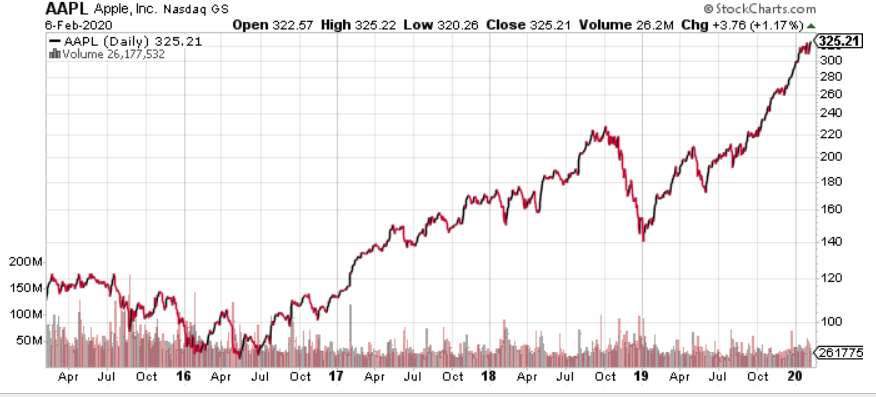This Could Be the Key to Finding the Next Apple Inc.
Marijuana Business, Stocks, Finance, & Investing February 11, 2020 MJ Shareholders 0

 The Secret Behind a Soaring Ticker
The Secret Behind a Soaring Ticker
Remember the days when people were bearish about Apple Inc. (NASDAQ:AAPL), even when it was trading around $100.00?
I remember those days very clearly. Because Apple was known as a hardware device maker, AAPL stock was never short of skeptics. Even Wall Street firms had doubts about the company’s outlook.
One analyst said in 2015, “Can Apple find new geographies to drive growth? Probably not. Will they be able to lift the average selling price? Probably not. Are they dependent on the “iPhone?” Yes. There’s only so much room to grow.” (Source: “Why Apple stock has plunged 15% from its all-time high,” CNN, August 4, 2015.)
Around the same time, a portfolio manager said, “We tend to avoid hit-driven companies. As great as Apple has been, they have to continue innovating.” (Source: Ibid.)
And they seemed to be right, at least at first. Apple stock dipped below $100.00 in early 2016 and traded at subdued levels for quite a while.
But those days are long gone.
Even though Apple was already a massive company, commanding hundreds of billions of dollars of market capitalization back when it was trading at $100.00 per share, its stock price managed to more than triple.
Trading at $322.82 and boasting a market cap of a whopping $1.4 trillion at the time of this writing, Apple Inc. is now the largest company listed on U.S. stock exchanges.
To be honest, I hopped on the bullish bandwagon relatively early. In May 2016, when AAPL stock was trading in the $90.00 range, I wrote a piece explaining why the company could present a huge opportunity to investors.
I even went as far as saying, “If you’re betting against Apple stock now, be warned; you’ll be kicking yourself later.”
Obviously, I’m no oracle. But I did see something that differentiates Apple from most other device makers: recurring business.
Why Apple Inc. Is Special
At the time of AAPL stock’s downturn in 2016, there were two other well-known device makers experiencing stock sell-offs: Fitbit Inc (NYSE:FIT) and GoPro Inc (NASDAQ:GPRO). Fitbit makes fitness trackers and GoPro makes action cameras.
Both companies had already made their names by the time they went public, and they were actually hot tickers at one point. GoPro completed its initial public offering (IPO) in June 2014 at $24.00 per share. Within a few months, the stock was trading at over $80.00.
But the rally did not last long. GPRO stock started to fall sharply in mid-2015 and never really recovered. Today, it trades at just $4.08 apiece. Ouch!
Fitbit went public in June 2015 with an IPO price of $20.00.
FIT stock rallied above $45.00 in just a couple of weeks after the IPO, but like GPRO, it was not able to maintain the upward momentum. After the downtrend started, FIT was mostly trading in the single-digit range.
On November 1, 2019, Fitbit Inc announced that it would be acquired by Google LLC for about $2.1 billion. (Source: “Fitbit to Be Acquired by Google,” Fitbit Inc, November 1, 2019.)
That news lifted Fitbit stock quite a bit, but trading at $6.64 apiece right now, it’s still well below its IPO price.
I should point out that neither company makes bad products. I would even say that both GoPro and Fitbit are leading players in their respective markets.
The reason why investors aren’t very enthusiastic about these companies lies in the business model of a device maker.
You see, if you are a manufacturer of electronic gadgets, you earn revenue every time a device is sold. If you come up with a hot product that everybody wants in one year, sales could be tremendous in that year.
But if consumers don’t want to buy the product repeatedly, and the company doesn’t come up with a hot new gadget, next year’s sales probably won’t be as good. Investors don’t like that kind of uncertainty.
That concern also had an impact on Apple stock, at least for a while. But for the most part, Apple Inc. kept demonstrating that, even though it was a hardware device maker, its business was still recurring.
Let me show you what I mean by looking at the company’s fiscal 2016 third-quarter results. The reason I chose this particular quarter was twofold.
First, Apple was a beaten-down stock at the time and the bears hated it.
Second, the company’s flagship smartphones at the time were the “iPhone 6S” and “iPhone 6S Plus,” which were released in September 2015. They weren’t considered that big of an upgrade from the “iPhone 6” and “iPhone 6 Plus” models that came out in September 2014.
Moreover, everyone was anticipating the “iPhone 7” to come out in September 2016, so there wasn’t much incentive to buy a smartphone from Apple during that time. And when a new model gets released, the old models drop in price.
Here’s an important number from the 2016 third quarter: $24.0 billion.
That’s the revenue Apple generated just by selling iPhones in that particular quarter. (Source: “Apple Inc Q3 2016 Unaudited Summary Data” Apple Inc., July 26, 2016.)
Yes, despite analysts’ bearish opinions about AAPL stock and the timing of the company’s product upgrade cycle, Apple still managed to earn a huge amount of money from its smartphone business in that seasonally weak quarter. That $24.0 billion came from selling 40.4 million iPhones.
And when Apple released the iPhone 7, people lined up for it.
In the quarter ended December 31, 2016—the first full quarter with iPhone 7 sales—the company sold a whopping 78.3 million iPhones. (Source: “Apple Inc Q1 2017 Unaudited Summary Data,” Apple Inc., January 31, 2017.)
In that quarter, the company earned $54.4 million in sales just from its smartphone segment.
Later on, Apple stopped reporting unit sales figures for the iPhone, but the recurring business theme remained intact.
According to the company’s latest earnings report, there was strong demand for Apple’s current flagship models: the “iPhone 11” and “”iPhone 11 Pro.
In the quarter ended December 28, 2019, iPhones contributed $56.0 million of sales to Apple. (Source: “Condensed Consolidated Statements of Operations (Unaudited),” Apple Inc., January 28, 2020.)
What also cheered up investors was that, for the quarter, Apple generated $91.8 billion in total sales and earned net income of $4.99 per share. Both numbers were new all-time highs for the company.
And if you think recurring iPhone sales is all Apple has, think again. The real strength of the company lies not just in the appeal of its smartphones, but in its ecosystem.
You see, Apple Inc. uses its proprietary operating systems on all its devices. As the company sold more smartphones, tablets, and computers, it built a massive installed base. And that ecosystem of users has led to a booming services business.
In the company’s latest earnings conference call, Apple’s chief executive officer Tim Cook said the following:
Our active installed base of devices has now surpassed 1.5 billion, up over 100 million in the last 12 months alone, reaching a new all-time high for each of our main product categories and geographic segments. Not only is our large and growing installed base a powerful testament to the satisfaction, engagement and loyalty of our customers, but it’s also fueling our growth across the board, particularly in services.
(Source: “Apple Inc. (AAPL) CEO Tim Cook on Q1 2020 Results – Earnings Call Transcript,” Seeking Alpha, January 28, 2020.)
Indeed, Apple’s services segment, which includes “iCloud,” “Apple Pay,” “AppleCare,” and “Apple Music,” has been firing on all cylinders.
In Apple’s most recent quarter, its services revenue totaled $12.7 billion, which not only represented a 16.9% increase year-over-year, but also marked a new record for the company.
In just the past four years, Apple’s quarterly services revenue has more than doubled.
And since Apple users tend to use these services more than once (some services are actually subscription-based), the business model is recurring in nature. With an enormous installed base that’s still expanding, the company should have no problem continuing to grow its services revenue.
Apple Inc. (NASDAQ:AAPL) Stock Chart
Chart courtesy of StockCharts.com
Analyst Take
There are many up-and-coming tech firms in the stock market right now. And because the overall market has been going up, some of these tech stocks have been travelling on an upward trend.
However, if you take a closer look, you’ll see that not all of the companies have a recurring business model.
I’m not saying that the lack of recurring business would lead their stock prices to crash immediately, but as a long-term investor, I prefer companies that offer something that’s in demand year after year.
Apple is the perfect example of such a company, and its investors have been handsomely rewarded.
Of course, no two companies are the same, and Apple Inc.’s success is hard to replicate. But if you are able to identify the ones with durable and recurring business models, you just might find the next Apple-like opportunity.
MJ Shareholders
MJShareholders.com is the largest dedicated financial network and leading corporate communications firm serving the legal cannabis industry. Our network aims to connect public marijuana companies with these focused cannabis audiences across the US and Canada that are critical for growth: Short and long term cannabis investors Active funding sources Mainstream media Business leaders Cannabis consumers











No comments so far.
Be first to leave comment below.